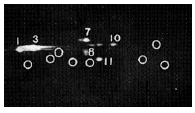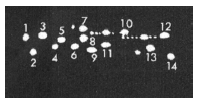Product Details
| Alternative Name: | Proteasome subunit α type-1, -2, -3, -4, -5 & -6, Macropain subunits C2, C3, C8, C9, ι & ζ |
| |
| Clone: | MCP231 |
| |
| Host: | Mouse |
| |
| Isotype: | IgG1κ |
| |
| Immunogen: | Dinitrophenylated proteasomes. |
| |
| UniProt ID: | P25786 (human PSMA1), P25787 (human PSMA2), P25788 (human PSMA3), P25789 (human PSMA4), P28066 (human PSMA5), P60900 (human PSMA6) |
| |
| Source: | Purified from ascites. |
| |
| Species reactivity: | Human, Mouse, Rat
Potato, Rabbit, Yeast
|
| |
| Specificity: | Recognizes the α1, 2, 3, 5, 6 & 7 subunits of the 20S proteasome. |
| |
| Applications: | IHC, WB
|
| |
| Purity Detail: | Protein G affinity purified. |
| |
| Formulation: | Liquid. In PBS containing 0.01% sodium azide. |
| |
| Use/Stability: | Dilute in PBS pH 7.2-7.4 and 1% normal goat serum (if a goat anti-mouse IgG linker antibody is to be used) |
| |
| Handling: | Store unopened vial at -20°C until required for use. Aliquot after opening and store at 2-4°C. The use of high quaity \'antiserum-grade\' plastic or glass vials is recommended. Use within 1 month. Avoid freeze/thaw cycles. |
| |
| Shipping: | Blue Ice |
| |
| Long Term Storage: | -20°C |
| |
| Scientific Background: | The proteasome is widely recognised as the central enzyme of non-lysosomal protein degradation. It is responsible for intracellular protein turnover and it is also critically involved in many regulatory processes and, in higher eukaryotes, in antigen processing. The 26S proteasome is the key enzyme of the ubiquitin/ATP-dependent pathway of protein degradation. The catalytic core of this unusually large (2000kDa, 450Å in length) complex is formed by the 20S proteasome, a barrel shaped structure shown by electron microscopy to comprise of four rings each containing seven subunits. Based on sequence similarity, all fourteen 20S proteasomal subunit sequences may be classified into two groups, α and β, each group having distinct structural and functional roles. The α-subunits comprise the outer rings and the β-subunits the inner rings of the 20S proteasome. Observations of the eukaryotic proteasome and analysis of subunit sequences indicate that each ring contains seven different subunits (α7β7β7α7) with a member of each sub-family represented in each particle. Each subunit is located in a unique position within the α- or β-rings. 120S Proteasomes degrade only unfolded proteins in an energy-independent manner, whereas 26S proteasomes degrade native and ubiquitinylated proteins in an ATP-dependent manner. The native protein substrates are recognised by subunits, some with ATP binding sites, of the outer 19S caps of the 26S proteasome. The hybridoma secreting the antibody to subunits HC2, HC3, HC8, HC9, Iota and Zeta was generated by fusion of spenocytes from Balb/c mice which had recieved repeated immunisation with dinitrophenylated proteasomes. |
| |
| Technical Info/Product Notes: | Various systems for the nomenclature of the proteasome subunits have been established. This may be a source of confusion as the system on UniProt differs from "standard" nomenclature as described in the literature. The UniProt ID and Gene Name will help to clearly identify the proteins. |
| |
| Regulatory Status: | RUO - Research Use Only |
| |

Figure:Luminograph of human placental proteasome preparation after 2D PAGE followed by blotting onto nitrocellulose and probing with antibody Prod. No. BML-PW8195 (MCP231). Antibody dilution 1:1000 using ECL procedure (1 min exposure).

Figure:Ponceau S staining of human placental proteasome preparation after 2D PAGE followed by blotting onto nitrocellulose.
Please mouse over
Product Literature References
BAP1 Malignant Pleural Mesothelioma Mutations in Caenorhabditis elegans Reveal Synthetic Lethality between ubh-4/BAP1 and the Proteasome Subunit rpn-9/PSMD13: C. Martínez-Fernández, et al.; Cells
12, 929 (2023),
Abstract;
Assembly checkpoint of the proteasome regulatory particle is activated by coordinated actions of proteasomal ATPase chaperones: A. Nahar, et al.; Cell Rep.
39, 110918 (2022),
Abstract;
Fish Oil Diet during Pre‐mating, Gestation, and Lactation in Adult Offspring Rats on Cancer Cachexia Prevention: S.C.P. Oliveira, et al.; Mol. Nutr. Food Res.
65, e2000863 (2021),
Abstract;
Differentiation Drives Widespread Rewiring of the Neural Stem Cell Chaperone Network: W.I.M. Vonk, et al.; Mol. Cell
78, 328 (2020),
Abstract;
Tissue-specific Effects of Temperature on Proteasome Function: J. Pispa, et al.; Cell Stress Chaperones
25, 563 (2020),
Abstract;
Full Text
The p97-Ataxin 3 complex regulates homeostasis of the DNA damage response E3 ubiquitin ligase RNF8: A.N. Singh, et al.; EMBO J.
38, e102361 (2019),
Abstract;
Full Text
Activity-Dependent Degradation of the Nascentome by the Neuronal Membrane Proteasome: K.V. Ramachandran, et al.; Mol. Cell
71, 169 (2018),
Abstract;
Full Text
Cilostazol, a phosphodiesterase 3 inhibitor, activates proteasome-mediated proteolysis and attenuates tauopathy and cognitive decline: A.W. Schaler, et al.; Transl. Res.
193, 31 (2018),
Abstract;
Proteasome phosphorylation regulates cocaine-induced sensitization: F.R. Gonzales, et al.; Mol. Cell. Neurosci.
88, 62 (2018),
Abstract;
The conserved RNA recognition motif and C3H1 domain of the Not4 ubiquitin ligase regulate in vivo ligase function: H. Chen, et al.; Sci. Rep.
8, 8163 (2018),
Abstract;
Full Text
TRIM11 activates the proteasome and promotes overall protein degradation by regulating USP14: L. Chen, et al.; Nat. Commun.
9, 1223 (2018),
Abstract;
Full Text
Detection of active proteasome structures in brain extracts: proteasome features of August rat brain with violations in monoamine metabolism: P.A. Erokhov, et al.; Oncotarget
8, 70695 (2017),
Abstract;
Full Text
Phosphorylation of the 19S regulatory particle ATPase subunit, Rpt6, modifies susceptibility to proteotoxic stress and protein aggregation: E.M. Marquez-Lona, et al.; PLoS One
12, e0179893 (2017),
Abstract;
Full Text
Possible roles of the transcription factor Nrf1 (NFE2L1) in neural homeostasis by regulating the gene expression of deubiquitinating enzymes: H. Taniguchi, et al.; Biochem. Biophys. Res. Commun.
484, 176 (2017),
Abstract;
Long-term leucine supplementation aggravates prolonged strenuous exercise-induced cardiovascular changes in trained rats: G.B. Dos Santos, et al.; Exp. Physiol.
101, 811 (2016),
Abstract;
Metformin treatment modulates the tumour-induced wasting effects in muscle protein metabolism minimising the cachexia in tumour-bearing rats: A.G. Oliveira, et al.; BMC Cancer
16, 418 (2016),
Application(s): Immunoblotting,
Abstract;
Full Text
Importin-β facilitates nuclear import of human GW proteins and balances cytoplasmic gene silencing protein levels: D. Schraivogel, et al.; Nucleic Acids Res.
43, 7447 (2015),
Application(s): Immunofluorescence,
Abstract;
Full Text
Sestrin 2 Regulates PDGF Receptor beta (PDGFRβ) Expression by Modulating Proteasomal and Nrf2 Transcription Factor Functions: A. Tomasovic, et al.; J. Biol. Chem.
290, 9738 (2015),
Application(s): Western Blotting,
Abstract;
Full Text
Ubiquitin-independent proteosomal degradation of myelin basic protein contributes to development of neurodegenerative autoimmunity: A. Belogurov Jr, et al.; FASEB J.
29, 1901 (2015),
Abstract;
Full Text
TRIM5α associates with proteasomal subunits in cells while in complex with HIV-1 virions: Z. Lukic, et al.; Retrovirology
8, 93 (2011),
Abstract;
Full Text
General Literature References
Subunit arrangement in the human 20S proteasome: F. Kopp et al.; PNAS
94, 2939 (1997),
Abstract;
The 26S proteasome: subunits and functions: K. Tanaka et al.; Mol. Biol. Rep.
24, 3 (1997),
Abstract;
Human proteasomes analysed with monoclonal antibodies: K. B. Hendil et al.; Biochem. J.
305, 245 (1995),
Abstract;
Related Products














